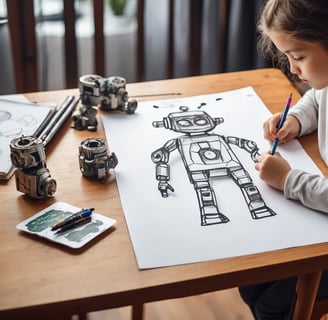The main types of Industrial Robots
There are several types of industrial robots available in the market, each suited to different purposes. The most common types of industrial robots include articulated robots, cartesian robots, SCARA robots, delta robots, polar robots, cylindrical robots, and collaborative robots or cobots.
ROBOT
Felipe Ferreira
1/12/20242 min read


Industrial robots have revolutionized the manufacturing industry by automating processes and increasing efficiency.
With the advancement of technology, there are now several types of industrial robots available in the market, each suited to different purposes. In this blog post, we will explore the most common types of industrial robots and their specific applications.
Articulated robots are the most common type of industrial robot and have an articulated arm that resembles a human arm. These robots are versatile and can be used for a wide range of applications, including welding, palletizing, painting, assembly, and material handling. The flexibility of their joints allows them to reach into confined spaces and perform complex tasks with precision.
Cartesian robots, on the other hand, are similar to articulated robots but are less expensive and highly customizable. These robots are ideal for applications that require precise linear movements, such as pick and place operations, packaging, and machine tending. Their simple design and ease of programming make them a popular choice for many manufacturing processes.
Delta robots are known for their speed and precision, making them the best choice for fast pick and place or product transfer applications. These robots are commonly used in the food and beverage industry for packaging and sorting tasks, as well as in the electronics industry for high-speed assembly processes.
Polar robots have an arm with two rotary joints and one linear joint connected to a base with a twisting joint. These robots are well-suited for applications that require a combination of precise linear and rotational movements, such as painting, sealing, and machine tending. Their unique design allows them to reach multiple points within their work envelope without the need for complex tooling.
SCARA robots, which stands for Selective Compliance Articulated Robot Arm, are used for assembly, packaging, and material handling. These robots have a fast and accurate vertical movement, making them ideal for applications that require high-speed and repetitive tasks. Their rigid structure and high payload capacity make them suitable for heavy-duty operations.
Cylindrical robots are another type of industrial robot used for assembly, material handling, and machine tending. These robots have a cylindrical work envelope and are capable of performing tasks in a 360-degree radius. Their compact design and ability to work in tight spaces make them a popular choice for applications with space constraints.
Finally, Collaborative robots or Cobots are robots that can directly and safely interact with humans in a shared workspace. These robots are designed to work alongside human workers, assisting them with tasks that require precision and repeatability. Cobots are equipped with advanced safety features, such as force and torque sensors, to ensure safe collaboration with humans.
In conclusion, the choice of industrial robot depends on the specific requirements of the application. Whether it's the need for speed, precision, flexibility, or human-robot collaboration, there is a type of industrial robot suited for every manufacturing process. Understanding the capabilities and limitations of each type of robot is crucial in selecting the right solution for a particular application. As technology continues to advance, we can expect to see even more innovative types of industrial robots entering the market, further transforming the manufacturing industry.


